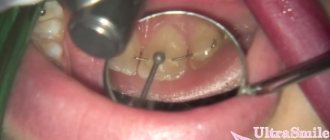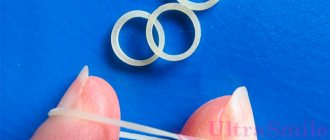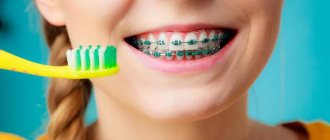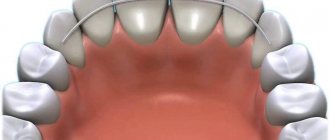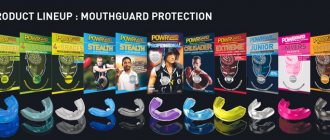Correcting a bite is a complex and lengthy process that requires a lot of patience. But not everyone knows that treatment does not end with wearing braces. The fact is that the design of brace systems requires a fairly quick correction of the patient’s tooth position, but it cannot guarantee the stability of the result. This is due to the structure of the jaw and other natural factors. To consolidate progress after braces, a retainer is installed and left for the required period.
About retention, the mechanisms of its occurrence and consequences, read the article: What are impacted teeth, why do they appear and how to treat them...
What are they and for what purposes are they installed?
What are retainers after braces ? This is the name of a type of orthodontic splint that is worn during the retention period. This is the time when the tooth tends to return to its original position. The retainer prevents curvature until the bite becomes permanent.
A return to the incorrect position of the teeth in the mouth occurs due to the peculiarities of their structure. The fact is that in addition to the usual position, the tooth has a ligamentous apparatus. The ligaments are much more conservative than the bite itself; they strive to return everything to the way it was. It takes a lot of time to retrain ligaments and muscles. Orthodontic retainers help fight muscle memory, which tends to ruin your teeth again.
Until recently, doctors believed that after correcting the bite, teeth remain straight for life. Today it has been proven that this is a myth.
Types of designs and their differences
There are several types of retainers for teeth after braces . It is better to choose the most suitable one together with your doctor. Devices can be classified by size and type of material, but the classic basis for dividing products into groups is the ability to independently remove the simulator. So, there are fixed and removable retainers . Each type has its own characteristics and advantages.
Fixed retainers
Models that cannot be removed are more popular, so first you should understand what it is - a non-removable retainer . The device is a small fixing wire that is attached to the inside of the teeth. It is installed by the doctor immediately after the braces are removed.
The non-removable structure is almost impossible to see
There have been many studies on the effect of wire on teeth . Most dentists agree that the product is absolutely safe for enamel. It is attached with a special composite material and practically does not interfere with the patient.
On average, after the installation of retainers , a week must pass for the patient to stop noticing them. The only inconvenience he faces is the need for more thorough brushing of his teeth. While wearing it, it is recommended to use a special irrigator with an attachment that provides more thorough oral care.
Removable structures
A removable retainer is also called a “retention mouth guard.” At its core, the device is the same aligner with a metal arch, which does not need to affect the bite. Unlike removable systems, such systems require diligence and pedantry from the patient: it is necessary to strictly follow the doctor’s instructions, wear the products for the prescribed time, day and night.
Often, a removable retainer becomes an addition to a fixed model. Then it is worn overnight and removed for the day, but the wire remains on the teeth for 24 hours. Such measures are necessary if the doctor notices very strong bite resistance or if the wire is not effective enough for some molars or incisors.
Removable retainers are easy to put on but still noticeable on the teeth.
There are two types of removable retainers after braces :
- for both jaws. They are usually prescribed to be worn during the night, since such designs do not allow talking or drinking;
- retainers on the upper jaw or lower jaw - as necessary. Such models can be prescribed instead of a non-removable device, then they will have to be worn more often.
If non-removable models require the patient to spend time thoroughly cleaning the oral cavity, then when wearing removable ones, you may notice that this dental retainer requires more attention and care. It is advisable to regularly rinse and clean it according to the manufacturer’s instructions.
Another type of removable retainer. It is used less often, because hard elements harm the teeth and are very noticeable.
In some cases, the doctor gives preference to newer means - trainers. Read more about them in a separate article: Trainers for teeth straightening: description, varieties, tips for use...
Removable retainers
Pros and cons of a removable retainer
The advantages of removable retention products are:
- the use of the device is not permanent—the patient himself chooses the time to use the device. The main condition is that this time is no less than 10 -12 hours;
- ease of use - the ability to remove the retainer yourself before eating or having an important meeting;
- Hygiene procedures are not difficult - brush your teeth and removable retainer twice a day with a toothbrush and toothpaste, after eating you need to rinse your mouth with warm water and install a retainer.
The disadvantages of using removable retainers are the following:
- Possible difficulties with articulation;
- the presence of a foreign object in the mouth often causes increased activity of the salivary glands;
- the need for frequent visits to the dental office;
- metal structural elements can provoke an allergic reaction.
Duration of use of a removable retainer
The time required to consolidate the result is individual for each patient. The duration of retention is affected by:
- complexity of the corrected defect;
- patient's age;
- duration of therapeutic treatment.
As a rule, the retention period lasts twice as long as the active period.
What is the procedure for removing retainers?
Removal, as well as fixation, of a non-removable retainer occurs only in the dental office.
There are certain arguments in favor of removing the retention device by an orthodontist:
- The metal arch is attached using a composite material and it is not possible to remove it without damaging the tooth enamel.
- Only the attending orthodontist can determine the end of the period of occlusion stabilization. Premature removal of the structure will eventually make all the efforts and time spent on correcting defects in the dentition (not to mention the money) in vain.
The procedure for removing the retainer is as follows:
- The retainer is removed using a dental bur, which removes the composite material that secures the metal arch to the lingual side of the teeth.
- The surface of the tooth at the site where the retainer is attached must be polished to eliminate possible roughness and minor residues of the composite material.
- The treated areas of tooth enamel are remineralized to eliminate their increased sensitivity.
The procedure for professional hygienic cleaning after removing retainers can be carried out only if the sensitivity of the tooth enamel is not impaired.
Abrupt abandonment of retention products is undesirable. Therefore, after removing non-removable retainers, the orthodontist will prescribe the use of a removable orthodontic structure - mouthguards, plates. Gradually reducing the time you wear the device will help avoid relapse.
What are the pros and cons
The pros and cons of retainers after braces are removed depend on the type of design used. The general advantages are the consolidation of the treatment result, after which the doctor can guarantee that the teeth will remain straight for many years.
Advantages and disadvantages of fixed models
The main advantages of models that are permanently attached to the bite are:
- constant impact on the tooth, reducing the risk of reducing the effectiveness of procedures;
- absence of unpleasant sensations during the installation of retainers and their subsequent wearing;
- quick adaptation to the product (some get used to it immediately, others within a week);
- absence of external signs of the presence of a dental retainer , which is especially important for patients who need to work with people.
Patients who use such models say that a non-removable retainer is a tool that creates inconvenience only at first. Brushing your teeth is a little difficult at first, but compared to cleaning your teeth while wearing braces, it's nothing. Also considered disadvantages are the need to visit the dentist and periodic damage to the wire, due to which it is necessary to organize an unscheduled visit to the doctor.
Many people choose non-removable models, because such a retainer is not visible in the photo and it does not interfere with the smile. If you don't tell the person you're wearing a device, no one will know about it.
Advantages and disadvantages of removable models
The removable retainer gets a lot of good reviews thanks to the following advantages:
- you don’t need to wear it all the time, you can put it on only at night (the timing and regularity of wearing it depend on your doctor’s recommendations);
- allows you to get a break from the presence of hard structures in the mouth after treatment with braces;
- Easy to clean with a special brush and paste.
The main disadvantage of the appliance is that it is a visible dental retainer . During the day, when the plate is in the mouth, it significantly changes the appearance of the smile. This can cause complexes and inconveniences. Also, for some, the design leads to increased salivation, which is quite inconvenient.
There are cases when a doctor prescribes the installation of two types of retainers at once: a fixed structure on one jaw and wearing a mouthguard on the other.
Why is it important to wear mouthguards after braces are removed?
Most patients are unaware that straightening teeth using braces is only the first stage of complex restorative treatment. However, being encouraged by the results should not prevent you from continuing treatment.
If you neglect the need to resort to wearing removable orthodontic structures, the teeth will again begin to occupy their previous incorrect position.
And then all the work done, money and time spent on straightening teeth will be in vain.
Overconfidence will result in such a patient having to have braces installed again to realign the teeth.
How does the installation process work?
A retainer after braces is placed in the doctor's office. The process takes place in several stages:
- Preparation of the oral cavity. First you need to make sure that years of wearing braces have not damaged the enamel. The doctor also checks for the presence of caries, removes plaque, and applies a protective layer to the enamel;
- Manufacturing of a retention apparatus. Since retainers are placed on specific teeth, they are usually made specifically for the patient.
- The wire-tire is fixed with special composite materials.
In the video below you can see how retainers are installed using the indirect fixation method.
If we are talking about a mouthguard, you can put it on yourself. But usually the doctor controls the process, because this helps to adjust the dental retainer to the shape of the jaw. There are models that are made to order, and there are thermally modeled ones that can be adjusted to the bite after heating.
How long will you have to wear the structure?
Only a doctor can tell you how long to wear retainers For one person a year is enough, for another it will take several years. You can only estimate approximate times: to do this, multiply the time you spent with the bite correction system by two. The average is from 3 to 6 years, but everything is very individual.
There are exceptions in which there are no strict terms for wearing a retainer after braces . If the process of muscle training is very slow, you will have to walk with the plate all your life.
How does the withdrawal process work?
The aligners are easily removed from the teeth and must be removed from the mouth for morning and evening care. But a non-removable retainer will have to be removed by a doctor after the braces are removed . But don't rush into this decision. If the product does not bother you, continue wearing it.
Is it possible to remove the wire yourself?
The composite material on which the tape is attached sometimes flies off on its own. Therefore, in theory, the device can be removed independently. But you need to understand that removing a dental retainer without a doctor is a big risk. You can damage the enamel and tooth. Just ask your orthodontist for help, and he will remove the wire in a few minutes.
Types of retention guards
In the vast ocean of modern retention guards, the following types can be distinguished:
- Standard : manufactured according to a single sample. This type is inexpensive. The disadvantage of such devices is that they are not ideal for everyone. Therefore, it can be problematic to perfectly fix this type of mouth guard.
- Thermoplastic : These are made from a material that becomes malleable when immersed in hot water. In this state, the plastic mass is applied to the dentition, after which it takes the shape of the jaw and hardens.
- Individual : this is the most advanced type of removable structures, which is ideally adjusted to the patient’s jaws. Such mouthguards are made from plaster casts that are taken from the patient’s dentition. Ready-made mouthguards completely repeat the shape of each person’s jaw, taking into account all the tubercles, irregularities and all the anatomical features of the teeth. Typically, the average production time for such structures is about a week. But the result, as a rule, satisfies even the most capricious patients. The only drawback of this type of mouthguard is their high cost.
The use of computer technology allows us to produce ultra-precise aligners such as Invisalign and ClearCorrect. This type of mouthguard fits perfectly to the teeth, repeats all the irregularities of the teeth and is the most advanced (albeit expensive).
Regular standard mouth guards are affordable, but sometimes cause discomfort. They are often combined with non-removable wire retainers, which increase the effectiveness of treatment. Wire structures are attached to the inside of the teeth and remain invisible.
Frequently asked questions about wearing retainers
Retainers are a popular product many people wear after braces Therefore, many questions arise about him. The DENT-HUNTER team has prepared answers to the most important of them. If we didn't take something into account, ask questions in the comments.
How to brush your teeth with a permanent retainer?
With retainers, after removing braces, you need to pay maximum attention to brushing your teeth. It goes like this:
- First, you brush your mouth by running the bristles over your teeth from top to bottom several times.
- Take a brush and use it to clean the gaps behind the retainers.
- If there is food left between the teeth, it is removed with floss.
Many patients believe that fixed retainers are a device that provokes the appearance of tartar. It is a myth. But caries can actually develop due to poor care. Therefore, it is advisable to use an irrigator and regularly have professional cleaning of the oral cavity.
An irrigator will make brushing your teeth easier
How to care for a removable retainer?
Caring for removable structures is extremely simple. You need to brush them regularly with a toothbrush, rinse them before placing them in your mouth, and use a special disinfectant solution once a week. Don't forget to wash the device both inside and outside - bacteria and dirt accumulate on both sides.
What to do if the retainer breaks or comes off?
The patient’s behavior in the event of a breakdown depends on how long the retainers need to be worn and how long has passed since installation:
- If you have recently put on the device, it is advisable to go to the doctor immediately. The reason is that teeth can break apart in a very short time, and other treatment will have to be prescribed.
- For those patients who have been wearing a retainer after braces for several years, you can wait a few days. But don’t delay anyway – the cost of delay can be quite high!
Is it possible to do an MRI?
The resolution of an MRI depends on the type of metal used in the wire. MRI is a magnet that attracts metal, which can be dangerous for those who wear retainers. In general, it is better to avoid this procedure. Most often, MRI can be replaced with computed tomography.
Nuances when wearing mouth guards
There are some inconveniences to wearing mouth guards that patients need to be aware of. Here are the main ones:
- At first, the mouthguards may cause slight discomfort. However, after some time, most patients get used to these devices. Wearing soft aligners does not cause pain (unlike wearing braces).
The only reason for pain during treatment with mouth guards is if the patient has not worn them for some time.
This signals that the teeth are trying to take their original incorrect position.
- At first, wearing mouthguards often causes patients to have defects in the pronunciation of various sounds (usually hissing and whistling).
- Most aligners are made from clear polymers. Wearing them usually remains unnoticed and does not cause a stir among colleagues or relatives.
- Some patients get tired of wearing mouth guards for long periods of time. And then some people allow themselves a little break from using aligners. But in advance I would like to warn patients against such a frivolous attitude towards this stage of treatment.
Even if you don’t wear mouth guards for one day, they begin to have difficulty fitting onto your teeth.
This suggests that in the absence of retaining structures, the teeth immediately begin to “move”, that is, they try to take the wrong position again. Therefore, if you stop wearing mouth guards for braces, this can negate all the efforts and remedies of the entire treatment to straighten your bite.
Conclusions. Expert advice
The retention period is a very important part of correcting dental pathologies. If the patient behaves incorrectly at this time, the effect may well come to naught. The problem can be prevented using special removable or non-removable devices. They are called retainers.
Main features of orthodontic appliances:
- Requires regular wear for several years.
- They can be removed or attached to the teeth for life - it depends on the patient and the characteristics of his body.
- They require special attention to oral hygiene, the use of an irrigator and brushes.
- They must be worn under the supervision of a specialist.
Doctors know that it is the dental retainer that keeps the bite in the correct state until the muscles get used to the new position of the molars, incisors and canines. It is mandatory to wear the device. If problems arise with any type of orthodontic design, you can always choose another option that will better suit the patient.
Care of mouth guards
No particularly complicated care is required for the aligners. However, it is necessary to monitor the condition of the structures and maintain oral hygiene from the first days of wearing this device.
The main thing is to follow a number of rules that should become a habit. Here are the main ones:
- To avoid deformation, mouthguards should not be exposed to high temperatures. It is strictly forbidden to use boiling, steaming, using hot water or drying over hot surfaces to disinfect aligners. It is also not recommended to drink too hot drinks or food while wearing a mouthguard.
To keep the polymer pad clean, it should be cleaned with a regular toothbrush and rinsed with water.
- For cleaning, use the same toothpaste as for brushing your teeth. It is best to clean your aligners in the morning, evening and afternoon, if possible. If the aligners are not cleaned for a long time, an unpleasant taste appears in the mouth, and food debris accumulates under the plastic structures.
- Even if the patient did not wear the mouth guards during the day, it is better to wash and clean them in the evening (to prevent the growth of serious pathogenic bacteria). After all, it is prohibited to use any type of heat treatment for plastic mouthguards.
- Sometimes experts recommend special solutions that disinfect the pad and prevent it from becoming covered with plaque.
- It is very convenient to use special cases for caring for mouthguards and carrying them. The range of such boxes is quite wide; they are compact and have special holes. But thrifty patients use cleanly washed jars of some cream to store their trays. After all, the main thing here is not design, but cleanliness and convenience. In this type of design you can always carry it with you.
